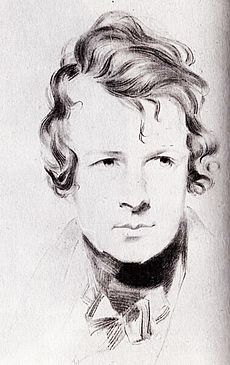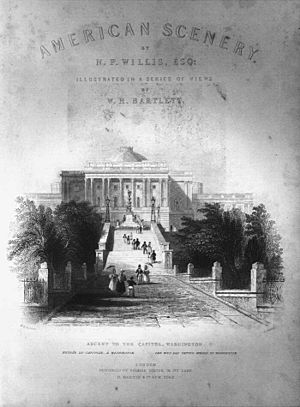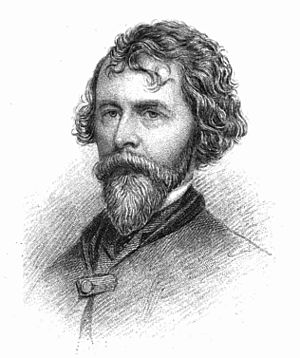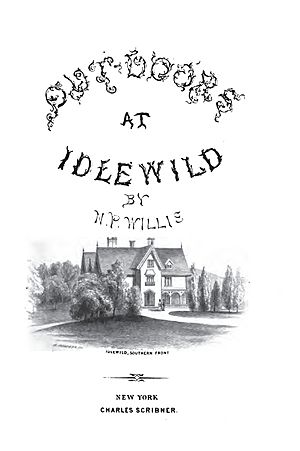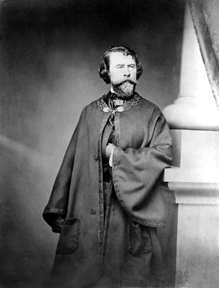Nathaniel Parker Willis facts for kids
Quick facts for kids
Nathaniel Parker Willis
|
|
|---|---|
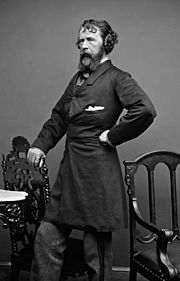
Portrait of Willis by Mathew Brady studios, circa mid-1850s
|
|
| Born | January 20, 1806 Portland, Maine, U.S. |
| Died | January 20, 1867 (aged 61) Cornwall-on-Hudson, New York, U.S. |
| Resting place | Mount Auburn Cemetery, Cambridge, Massachusetts |
| Occupation | Editor Literary critic Poet |
| Signature | |
Nathaniel Parker Willis (born January 20, 1806 – died January 20, 1867), also known as N. P. Willis, was a famous American writer, poet, and editor. He worked with many well-known American authors, including Edgar Allan Poe and Henry Wadsworth Longfellow. During his time, he became the highest-paid magazine writer.
Willis came from a family of publishers. His grandfather, Nathaniel Willis, owned newspapers. His father, Nathaniel Willis, started Youth's Companion, the first newspaper made just for children. Nathaniel Parker Willis's sister, Sara, became a writer known as Fanny Fern. Also, Harriet Jacobs, who wrote an important autobiography, worked as a nurse for his children.
Willis was born in Portland, Maine. He became very interested in writing while studying at Yale College. After graduating, he worked as a reporter in Europe for the New York Mirror. He later moved to New York and became very famous for his writing. He earned a lot of money, sometimes $100 for one article! In 1846, he started his own magazine, the Home Journal, which is now called Town & Country. Willis then moved to a home by the Hudson River, where he lived a quieter life until he passed away in 1867.
Willis often put his own feelings into his writing. He would talk directly to his readers, especially in his travel writing. This made people feel like they knew him. Some critics, including his sister, sometimes said his writing seemed too fancy or European. Willis also wrote many poems, stories, and a play. Even though he was very popular for a while, people almost forgot about him after he died.
Contents
Life and Career
Early Life and Family Background
Nathaniel Parker Willis was born on January 20, 1806, in Portland, Maine. His father, Nathaniel Willis, owned a newspaper there. His grandfather also owned newspapers in other parts of America. Willis's mother was Hannah Willis.
Nathaniel had several siblings. His younger sister, Sara Willis Parton, later became a famous writer using the name Fanny Fern. His brother, Richard Storrs Willis, was a musician. He is known for writing the tune for the Christmas carol "It Came Upon the Midnight Clear".
In 1816, Willis's family moved to Boston. There, his father started the Boston Recorder newspaper. Nine years later, he launched Youth's Companion. This was the first newspaper in the world made especially for children.
Willis went to school in Boston and then to Phillips Academy. In 1823, he started at Yale College. At Yale, he became very interested in literature and writing. He often spent more time on his writing than on his other studies. He finished college in 1827. After that, he traveled around the United States and Canada. He started publishing his poems in his father's newspaper.
Starting a Writing Career
In the late 1820s, Willis began writing more often for magazines. In 1829, he worked as an editor for a special book called The Token. That same year, Willis started his own magazine, the American Monthly Magazine. It was published from April 1829 to August 1831.
After his magazine closed, Willis moved to Europe. He worked as a foreign reporter for the New York Mirror newspaper. In 1832, while in Italy, he met a sculptor named Horatio Greenough. Greenough made a statue of Willis's head.
Between 1832 and 1836, Willis sent many letters back to the Mirror. About half of these letters were later put into a book called Pencillings by the Way. This book was printed in London in 1835. The book described his travels and life in Europe. It sold very well and made Willis quite famous.
However, some people criticized him. They said he shared private conversations in his writings. At one point, he even had a bloodless duel (a formal fight with no injuries) with another editor. Still, Willis was popular enough to introduce Henry Wadsworth Longfellow to important writers in England.
In 1835, Willis married Mary Stace in England. They spent their honeymoon in Paris. The couple then moved to London. In 1836, Willis met Charles Dickens, who was just starting his writing career.
Returning to America
In 1837, Willis and his wife came back to the United States. They settled on a small property in New York. He called his home Glenmary. This peaceful country setting inspired him to write Letters from under a Bridge.
On June 20, 1839, Willis's play Tortesa, the Usurer opened in Philadelphia. Edgar Allan Poe praised it, calling it "by far the best play from the pen of an American author." That year, Willis also edited a short-lived magazine called The Corsair. He even asked William Makepeace Thackeray to write for it.
Sadly, Willis faced personal sadness when his first child was stillborn in 1840. He and Mary had a second daughter, Imogen, in 1842.
By 1842, Willis was earning a very high salary for a writer, about $4,800 a year. This made him one of the first magazine writers to be paid so well.
The Evening Mirror Years
Willis moved back to New York City. In 1844, he and George Pope Morris started a new daily newspaper called the Evening Mirror. It also had a weekly magazine part. By this time, Willis was a very popular writer. He was one of the first American writers to become successful by writing for magazines. He earned about $100 for each article and $5,000 per year. This amount soon doubled! Even the famous poet Longfellow was a bit jealous of Willis's high pay.
As a critic, Willis believed that writers should not talk about other authors' personal lives when reviewing their books. He also thought newspapers should discuss important topics but not take sides in political arguments. The Mirror did very well when many other newspapers were closing. This showed that Americans were willing to support good writing. In 1845, Willis and Morris published a collection of American prose and poetry.
While Willis was editor of the Evening Mirror, he published Edgar Allan Poe's famous poem "The Raven" on January 29, 1845. It was the first time Poe's name was officially attached to the poem. Willis was a close friend of Poe. He helped Poe financially when Poe's wife, Virginia, was sick. Willis often tried to encourage Poe to focus on his poetry.
Willis's wife, Mary Stace, died during childbirth on March 25, 1845. Their baby daughter, Blanche, also died. Willis took his surviving daughter, Imogen, to England to visit her mother's family. In October 1846, he married Cornelia Grinnell. She was a wealthy woman who was twenty years younger than Willis. She strongly disliked slavery, unlike Willis.
The Home Journal and Idlewild
In 1846, Willis and Morris left the Evening Mirror. They started a new weekly magazine called the National Press, which was soon renamed the Home Journal. They wanted this magazine to be something for the whole family. Willis aimed the magazine at middle-class families. He often wrote about his own possessions and how he moved up in society. He edited the Home Journal until he died in 1867. The magazine is still published today as Town & Country. Willis especially supported women poets in his magazine. He also reviewed important books like Henry David Thoreau's Walden.
In 1846, Willis bought a home near the Hudson River in New York. He named it Idlewild. The previous owners thought the land was not useful, calling it "an idle wild." Willis built a large "cottage" with fourteen rooms. He worked closely with an architect to make sure the house had great views of the river and mountains.
Willis's health began to fail, so he spent most of his later life at Idlewild. His wife, Cornelia, was also recovering from an illness after their first child, Grinnell, was born in 1848. They had four more children: Lilian, Edith, Bailey, and a daughter who died shortly after birth.
In 1850, Cornelia Willis hired Harriet Jacobs again. Harriet was a former enslaved person from North Carolina who had worked for the family before. When Harriet's former owners came to New York in 1852 to try and force her back into slavery, Cornelia Willis bought Harriet's freedom for $300. While working for the Willis family at Idlewild, Harriet Jacobs wrote her amazing autobiography, which was published in 1861. It's interesting that this famous book was written in a place meant for a well-known writer, but it was his children's nurse who created a classic there.
During his last years at Idlewild, Willis continued to write a weekly letter for the Home Journal. In 1850, he helped Rufus Wilmot Griswold prepare a collection of Edgar Allan Poe's works. Poe had died mysteriously the year before. Griswold also wrote a biography of Poe that tried to damage Poe's reputation. Willis was one of Poe's strongest defenders. He wrote that Griswold's account was "full of cruel misrepresentations."
Family and Later Works
Willis stopped publishing his sister Sara Willis's (Fanny Fern) work in the Home Journal after 1854. She had been writing anonymous book reviews for him. She had recently become a widow and was struggling financially. Willis had even written a poem about her.
In 1854, Fanny Fern published her novel Ruth Hall. This book was a story based on her own difficult experiences in the writing world. In the novel, Nathaniel Willis was shown as "Hyacinth Ellet," a self-centered editor who tried to harm his sister's writing career. Willis did not complain publicly. But in private, he said he had done his best to help his sister during her hard times.
Some of Willis's later works included Hurry-Graphs (1851), Out-Doors at Idlewild (1854), and Ragbag (1855). He often complained that writing for magazines kept him from writing longer books. In 1856, he finally had time to write his only novel, Paul Fane, published a year later. His last work was The Convalescent (1859). This book included a chapter about his time with Washington Irving.
Final Years and Passing
In July 1860, Willis took his last big trip with his wife. They traveled to Chicago, Wisconsin, and down the Mississippi River to St. Louis.
In 1861, Willis allowed the Home Journal to break its rule about not taking sides in politics. He called the creation of the Confederate States of America an act to start a war. The Home Journal lost many readers during the American Civil War. Willis's business partner, Morris, died in 1864. The Willis family had to take in boarders and even turned Idlewild into a girls' school to earn money.
Willis was very sick in his final years. He suffered from severe epileptic seizures. He died on his 61st birthday, January 20, 1867. He was buried in Mount Auburn Cemetery in Cambridge, Massachusetts. On the day of his funeral, all bookstores in the city closed to show respect. Famous writers like Longfellow and James Russell Lowell were among those who carried his coffin.
Reputation and Legacy
Throughout his writing career, Willis was well-liked by his friends. He was known for being kind. He had traveled a lot and was very clever. He was also tall and always dressed nicely. However, some people thought Willis seemed too fancy or "European." One editor even called him "an impersonal passive verb—a pronoun of the feminine gender." A drawing from that time showed him wearing a stylish hat and coat, looking like a "dandy" (someone who cares a lot about their appearance). Willis put a lot of effort into how he looked and dressed.
Oliver Wendell Holmes, Sr. once said Willis was "something between a remembrance of Count D'Orsay and an anticipation of Oscar Wilde." Publisher Charles Frederick Briggs wrote that "Willis was too Willisy." He said Willis's writings were about "the novelty and gossip of the hour." He wasn't always concerned with facts, but with things that people would talk about.
Willis became famous at a time when readers were very interested in the personal lives of writers. In his books, he described the "high life" of the "Upper Ten Thousand" (a phrase he invented for the wealthy and fashionable people). His travel writings were especially popular because Willis was actually living the life he described. However, he also created a humble image for himself. He questioned his own writing skills and used titles that made his works sound less serious.
His informal articles, which covered many different topics, were also very successful. He used humor and a casual style to let his personality shine through. He spoke directly to his readers, as if he was having a private chat with them. He once wrote, "We would have you... indulge us in our innocent egotism as if it were all whispered in your private ear." When women poets became popular in the 1850s, he copied their style and focused on emotional and moral topics.
In the publishing world, Willis was known as a smart magazine editor. He was an innovator who focused on what readers were interested in. He also recognized new writing talent. In fact, Willis became the standard for other magazine writers. For a time, people said Willis was the "most-talked-about author" in the United States. However, Edgar Allan Poe doubted Willis's fame. Poe wrote, "Willis is no genius—a graceful trifler—no more."
By 1850, Willis was becoming a forgotten celebrity. After he died, obituaries (death notices) said that his fame had faded. One said, "the man who withdraws from the whirling currents of active life is speedily forgotten." However, this obituary also said that Americans "will ever remember and cherish Nathaniel P. Willis as one worthy to stand with Fenimore Cooper and Washington Irving."
Today, many scholars see Willis's work as "sentimental prattle." They often mention him only in connection to other authors like his sister or Harriet Jacobs. As one biographer wrote, Willis is now mostly a footnote in the stories of other writers.
Selected List of Works
Prose
- Sketches (1827)
- Pencillings by the Way (1835)
- Inklings of Adventure (1836)
- À l'Abri; or, The Tent Pitched (1839)
- Loiterings of Travel (1840)
- The Romance of Travel (1840)
- American Scenery (2 volumes 1840)
- Canadian Scenery (2 volumes 1842)
- Dashes at Life with a Free Pencil (1845)
- Rural Letters and Other Records of Thoughts at Leisure (1849)
- People I Have Met (1850)
- Life Here and There (1850)
- Hurry-Graphs (1851)
- Summer Cruise in the Mediterranean (1853)
- Fun-Jottings; or, Laughs I Have Taken a Pen to (1853)
- Health Trip to the Tropics (1854)
- Ephemera (1854)
- Famous Persons and Places (1854)
- Out-Doors at Idlewild; or, The Shaping of a Home on the Banks of the Hudson (1855)
- The Rag Bag. A Collection of Ephemera (1855)
- Paul Fane; or, Parts of a Life Else Untold. A Novel (1857)
- The Convalescent (1859)
Plays
- Bianca Visconti; or, The Heart Overtasked. A Tragedy in Five Acts (1839)
- Tortesa; or, The Userer Matched (1839)
Poetry
- Fugitive Poetry (1829)
- Melanie and Other Poems (1831)
- The Sacred Poems of N. P. Willis (1843)
- Poems of Passion (1843)
- Lady Jane and Humorous Poems (1844)
- The Poems, Sacred, Passionate, and Humorous (1868)
Images for kids
See also
 In Spanish: Nathaniel Parker Willis para niños
In Spanish: Nathaniel Parker Willis para niños


